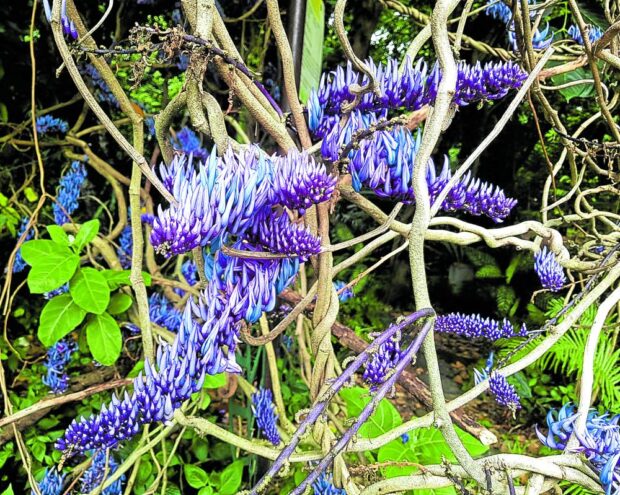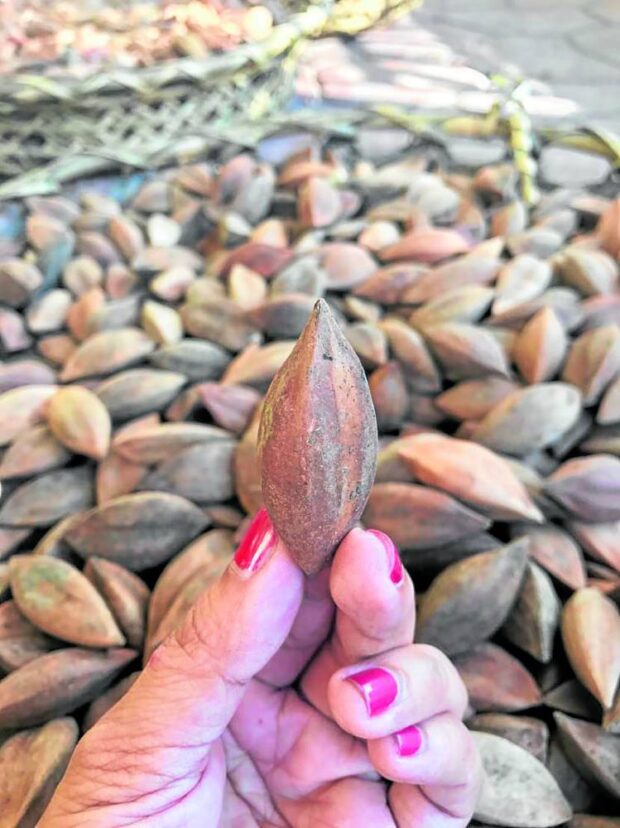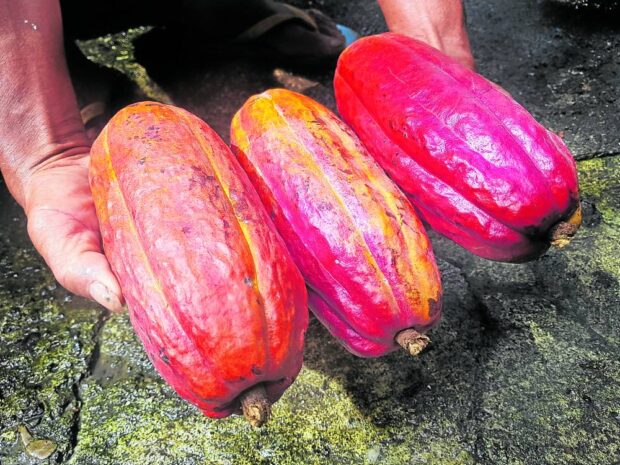The unsung value of native Philippine plants

The entrance to the UPIB-EDC Threatened Species Arboretumin Diliman, Quezon City. (PHOTOS BY GREGG YAN AND ANGELIQUE OGENA)
What are the most familiar Pinoy fruits? Mangoes, bananas, pineapples, and papayas probably come to mind—but did you know that Philippine forests harbor hundreds of lesser-known fruits, nuts, and herbs?
Alupag or Philippine lychee tastes like the lychees originally imported from China. Saba or native bananas are loved by millions of Pinoys. Kamansi is our local version of langka. Sticky tibig fruits are produced by our native fig trees. In our mountains sprout sour berries like alingaro, bignay and sapinit. And though most of the world’s mango trees originally hailed from India, we have our own indigenous mangoes like pahutan and the fragrant kuini.
The Philippines has strong agrobiodiversity resources. The Convention on Biological Diversity defines agrobiodiversity as a broad term that includes all components of biological diversity relevant to food and agriculture, plus all components of biological diversity that constitute agricultural ecosystems or agroecosystems. This includes the variety and variability of animals, plants and microorganisms at the genetic, species, and ecosystem levels that sustain key functions of agroecosystems. Agrobiodiversity covers not just genetic resources, but the diversity of all species and agroecosystems affecting agriculture.
The pandemic and post-pandemic periods, coupled with intensifying climate change effects, have highlighted the importance of agricultural diversity and biodiversity-friendly agriculture, plus the global rethinking of our agriculture and food systems.
These new concepts now form the foundation for economically viable, resilient, and sustainable agriculture. Discussing agrobiodiversity is not just about conservation and sustainable use but about the eventual need for a systematic evolution of prevalent agricultural systems toward a more biodiversity-friendly paradigm.
Article continues after this advertisement
The rare JC’s Vine
UP Arboretum treasures
Inside the sprawling University of the Philippines (UP) Diliman campus in Quezon City lies the UP Institute of Biology and Energy Development Corp.’s (UPIB-EDC) Threatened Species Arboretum. Inaugurated in 2014, the one-hectare park features over 70 native tree species and serves two vital functions — as a gene bank for endangered trees in case wild populations drop below sustainable levels and to educate students and the greater public about the country’s native flora.
Article continues after this advertisementThis writer recently visited the UP Arboretum in connection with the observance of the International Day for Biological Diversity. The occasion, marked every May 22, is a United Nations campaign highlighting global biodiversity issues and solutions.
“We have so many indigenous tree species that very few Pinoys know about,” explains Roniño Gibe, a forester for EDC’s Binhi program. “One of our goals is to popularize the conservation of our native plants, especially our threatened Philippine native trees.”
Though definitions slightly vary, in general, native plants naturally occur throughout a country, whereas indigenous plants thrive only in particular locales. Endemic plants can only be found in one country, whereas naturalized plants are exotic imports that have settled into new countries over several centuries.

“Pili” nuts from the Bicol region
Eclipsed by the exotic
The Philippines hosts at least 10,107 plant species, as of a 2013 study by Barcelona et al. Over 57 percent of the country’s plants are endemic, as per a 1996 study by Oliver and Heaney. The great majority of plants currently cultivated in Pinoy orchards, farms, and gardens, however, are exotic or naturalized plants originally imported from other countries.
Pineapples for instance came from South America, papayas from Mexico, lanzones from Malaysia. The ubiquitous trees found in many abandoned lots, like sampaloc and aratilis, came from Africa and Central America, respectively. Despite being called the Philippine lemon, even the iconic calamansi probably originated from the Himalayas.
Some native Philippine plants, however, successfully broke through as mainstream products.
“The pili nut is a great example of an indigenous tree which became popular, with a following both in the Bicol region and abroad,” explains botanist David Ples.
Abaca, which is made from the fibrous stalks of a native Philippine banana, is another indigenous cash crop
“The key is to recognize these plants’ value and create useful, viable products,” adds David.
As pili trees and abaca plants have become economically valuable, their survival over the next generations is assured. The same cannot be said for other Philippine tree species, however.
Agrobiodiversity resources
As per the United Nations Development Programme (UNDP), biodiversity provides primary medicine for 4 billion people, while agrobiodiversity improves the lives of 1 billion undernourished people.
“[The program] promotes ethical, natural ways not just to produce food and other vital resources, but to find alternative livelihood opportunities for communities living in or near forestlands, and that are supportive of the UN Sustainable Development Goals,” says the UNDP resident representative to the Philippines, Dr. Selva Ramachandran.
“Our indigenous fruits, herbs, nuts and other products can provide vital nourishment for Pinoys who might not have ready access to mainstream food. Indigenous plants also have important vitamins and minerals that are sometimes deficient in the typical Pinoy diet,” explains Charina Javier, a senior science researcher at the Department of Science and Technology Food and Nutrition Research Institute. “However, many of our indigenous flora are neglected and underused, so their potential to provide us with nutrients is not fully utilized.”

Cacao fruits harvested in Panay Island.
Targets
The government has been working on the promotion of agrobiodiversity since 2015 and continues to achieve its agrobiodiversity targets under the Philippine Biodiversity Strategy and Action Plan.
Those targets include maintaining and conserving the genetic diversity of cultivated plants and farmed and domesticated animals and wild relatives, increasing areas devoted to biodiversity-friendly agricultural practices, formulating and adopting Comprehensive Land Use Plans that are ecologically sound under the revised Housing Land Use Regulatory Board framework, and increasing the number of nationally important agricultural heritage systems.
In some protected areas, the encroachment of agricultural lands has become so evident that the Department of Agriculture and the Department of Environment and Natural Resources (DENR) signed Joint Administrative Order (JAO) No. 2021-01, which mainstreams biodiversity-friendly agricultural practices in and around these sites.
The UNDP’s Biodiversity Finance Initiative (DENR-UNDP BIOFIN) is currently assisting the two national agencies to enable the implementation of the JAO. Established in 2012 as a network comprising 41 countries in Africa, Europe, South and Central America, and the Asia-Pacific region, the initiative helps raise funds for smart agriculture to boost the productivity of ecosystems, while repurposing potentially harmful agricultural subsidies into effective conservation measures.
“We should do all we can to strengthen local agrobiodiversity, such as promoting our native fruits,” says DENR-UNDP BIOFIN national project manager Anabelle Plantilla. “Native and even naturalized plants can be used for a host of purposes. Alupidan and pandan leaves [for example] can be used to garnish dishes, batuan fruits for flavoring, and rattan vines to make furniture.”
Food forests
According to the Forest Foundation Philippines, native trees are beneficial for threatened native flora and fauna species as they help recover and expand forest habitats, protect watershed and freshwater resources, secure the livelihood of local people and link protected areas with natural forests.
Food forests, or areas where various combinations of cash-crops are planted in a natural setting, instead of the endless monocrop rows which dominate large-scale agriculture, are slowly taking root.
“Food forests provide resilience to climate change because the cultivated crops are usually endemic and better suited to an area,” explains Muneer Arquion Hinay, cofounder of Kids Who Farm, a Zamboanga-based initiative to get youth interested in agriculture.
“They also promote better regeneration for they closely recreate natural forest ecosystems, where the symbiotic relationships of plants, fungi and other lifeforms [are] retained. Lastly, food forests can enhance soil health through improved soil cover from the leaves, twigs and natural biomass of its trees.”
Worth more than logs
At the Subic Bay Jungle Environment Survival Training Camp, where participants learn to survive in a tropical rainforest, campers are taught how to make “jungle coffee” from kupang seeds, how to use gugo vines as “jungle soap,” how to fashion survival implements from bamboo and what leaves one can chew on to help stave off hunger.
In the uplands of Sibalom in Panay, locals seasonally harvest the leaves and stems of bakan, balud, banban and nito to make tourist souvenirs, while locally grown tobacco leaves are ground and inserted into dried duhat leaves to make native cigarettes called lomboy or likit.
“Our forests serve many key functions. They provide habitats for wildlife, generate the oxygen we breathe, even offer us places to spiritually recharge,” says Plantilla.
“We can make them worth more than logs or farmland by seeing them as our First Nations (indigenous) people have for generations—as a pharmacy, a grocery and an extension of our home.”
* * *
Visitors interested in learning more about native Philippine trees, fruits, nuts, and herbs can schedule a visit via Facebook to the UPIB-EDC Arboretum, where donations for upkeep and maintenance are appreciated.